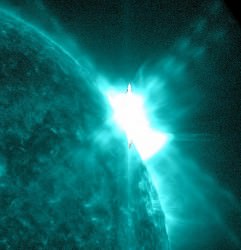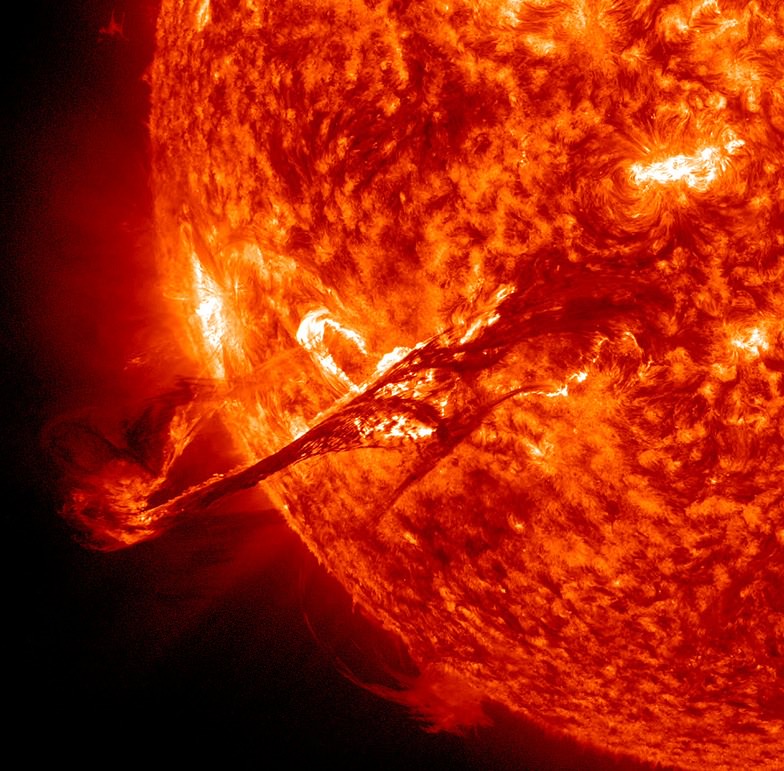We live on a planet dominated by weather. But not just the kind that comes in the form of wind, rain, and snow — we are also under the influence of space weather, generated by the incredible power of our home star a “mere” 93 million miles away. As we orbit the Sun our planet is, in effect, inside its outer atmosphere, and as such is subject to the constantly-flowing wind of charged particles and occasional outbursts of radiation and material that it releases. Although it may sound like something from science fiction, space weather is very real… and the more we rely on sensitive electronics and satellites in orbit, the more we’ll need to have accurate weather reports.
Fortunately, the reality of space weather has not gone unnoticed by the U.S. Federal Government.

Today the White House Office of Science and Technology Policy released a new report, Space Weather Observing Systems: Current Capabilities and Requirements for the Next Decade, which is an assessment of the United States government’s capacity to monitor and forecast potentially harmful space weather and how to possibly mitigate the damage from any exceptionally powerful solar storms in the future.
The report was made by a Joint Action Group (JAG) formed by the National Space Weather Program Council (NSWPC).
The impacts of space weather can have serious economic consequences. For example, geomagnetic storms during the 1990’s knocked out several telecommunications satellites, which had to be replaced at a cost of about $200 million each. If another “once in a century” severe geomagnetic storm occurs (such as the 1859 “super storm”), the cost on the satellite industry alone could be approximately $50 – $100 billion. The potential consequences on the Nation’s power grid are even higher, with potential costs of $1 – 2 trillion that could take up to a decade to completely repair.
– Report on Space Weather Observing Systems: Current Capabilities and Requirements for the Next Decade (April 2013)
“In other words,” according to the report, “the Nation is at risk of losing critical capabilities that have significant economic and security impacts should these key space weather observing systems fail to be maintained and replaced.”
Obviously, not good.
Read the full report here, and follow current and ongoing space weather events on the NOAA’s Space Weather Prediction Center website.
Source: White House Office of Science and Technology Policy
The National Space Weather Program is a Federal interagency initiative with the mission of advancing the improvement of space weather services and supporting research in order to prepare the country for the technological, economic, security, and health impacts that may arise from extreme space weather events.


I LOVE that obvious tornado shaped filament in that top image! You could say that I am attracted to it positively as it spins up my imagination!
Been doing R&D & peeking in checking in on Ole-Man-Sol’s habits going into my 5th decades now. Damn, I just scared myself! I’m old huh, …lol. My spirit is 19, but the rest of me? well,…falling apart…lol …take care H2O4U.
At one of the labs I work through. They have dozens of pics of those filaments. The one depicted here is one of the better ones. Too kool!
I taught my students a lesson in space weather. My neighbor actually works for NOAA Space Weather Division, so I have a little insight into the type of work they do and what kind of activity they see.
Kind of ironic, isn’t it? We have the best satellites available, watching, measuring, and photographing this solar maximum, and it is the weakest in centuries. Still makes for some great pictures, though.
The fact that this maximum is unusual might mean that we can learn more from it than from a normal one.
Been learning about spaceweather for awhile now. Great use of graphs, pics, etc. Must check it out. Look up SuspiciousObserver on YouTube. Puts out daily reports every morning.